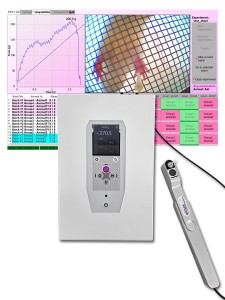Authors
D Tazewska, M Bajda, M Kaleta et al
Lab
Department of Technology and Biotechnology of Drugs, Jagiellonian University Medical College, Krakow, Poland
Journal
European Journal of Medicinal Chemistry
Abstract
Design and development of multitarget-directed ligands (MTDLs) has become a very important approach in the search of new therapies for AlzheimerÕs disease (AD). In our present research, a number of xanthone derivatives were first designed using a pharmacophore model for histamine H3 receptor (H3R) antagonists/inverse agonists, and virtual docking was then performed for the enzyme acetylcholinesterase. Next, 23 compounds were synthesised and evaluated in vitro for human H3R (hH3R) affinity and inhibitory activity on cholinesterases. Most of the target compounds showed hH3R affinities in nanomolar range and exhibited cholinesterase inhibitory activity with IC50 values in submicromolar range. Furthermore, the inhibitory effects of monoamine oxidases (MAO) A and B were investigated. The results showed low micromolar and selective human MAO B (hMAO B) inhibition. Two azepane derivatives, namely 23 (2-(5-(azepan 1-yl)pentyloxy)-9H-xanthen-9-one) and 25 (2-(5-(azepan-1-yl)pentyloxy)-7-chloro-9H-xanthen-9 one), were especially very promising and showed high affinity for hH3R (Ki = 170 nM and 100 nM respectively) and high inhibitory activity for acetylcholinesterase (IC50 = 180 nM and 136 nM respectively). Moreover, these compounds showed moderate inhibitory activity for butyrylcholinesterase (IC50 = 880 nM and 394 nM respectively) and hMAO B (IC50 = 775 nM and 897 nM respectively). Furthermore, molecular docking studies were performed for hH3R, human cholinesterases and hMAO B to describe the mode of interactions with these biological targets. Next, the two most promising compounds 23 and 25 were selected for in vivo studies. The results showed significant memory-enhancing effect of compound 23 in dizocilpine-induced amnesia in rats in two tests: step-through inhibitory avoidance paradigm (SIAP) and transfer latency paradigm time (TLPT). In addition, favourable analgesic effects of compound 23 were observed in neuropathic pain models. Therefore, compound 23 is a particularly promising structure for further design of new MTDLs for AD._
BIOSEB Instruments Used
Electronic Von Frey 4 (BIO-EVF4),Electronic Von Frey 5 with embedded camera (BIO-EVF5)
Source :
https://www.sciencedirect.com/science/article/pii/S0223523420307157

 Douleur - Allodynie/Hyperalgésie Thermique
Douleur - Allodynie/Hyperalgésie Thermique Douleur - Spontanée - Déficit de Posture
Douleur - Spontanée - Déficit de Posture Douleur - Allodynie/Hyperalgésie Mécanique
Douleur - Allodynie/Hyperalgésie Mécanique Apprentissage/Mémoire - Attention - Addiction
Apprentissage/Mémoire - Attention - Addiction Physiologie & Recherche Respiratoire
Physiologie & Recherche Respiratoire




































 Douleur
Douleur Système Nerveux Central (SNC)
Système Nerveux Central (SNC)  Neurodégénérescence
Neurodégénérescence Système sensoriel
Système sensoriel Système moteur
Système moteur Troubles de l'humeur
Troubles de l'humeur Autres pathologies
Autres pathologies Système musculaire
Système musculaire Articulations
Articulations Métabolisme
Métabolisme Thématiques transversales
Thématiques transversales Congrès & Meetings
Congrès & Meetings 
